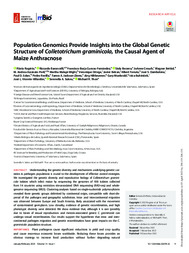Population genomics provide insights into the global genetic structure of Colletotrichum graminicola, the causal agent of maize anthracnose.
Population genomics provide insights into the global genetic structure of Colletotrichum graminicola, the causal agent of maize anthracnose.
Author(s): ROGÉRIO, F.; BARONCELLI, R.; CUEVAS-FERNÁNDEZ, F. B.; BECERRA, S.; CROUCH, J.; BETTIOL, W.; AZCÁRATE-PERIL, M. A.; MALAPI-WIGHT, M.; ORTEGA, V.; BETRAN, J.; TENUTA, A.; DAMBOLENA, J. S.; ESKER, P. D.; REVILLA, P.; JACKSON-ZIEMS; HILTBRUNNER, J.; MUNKVOLD, G.; BUHINICEK, I.; VICENTE-VILLARDÓN, J. L.''''; SUKNO, S. A.; THON, M. R.
Summary: Abstract: Understanding the genetic diversity and mechanisms underlying genetic variation in pathogen populations is crucial to the development of effective control strategies. We investigated the genetic diversity and reproductive biology of Colletotrichum graminicola isolates which infect maize by sequencing the genomes of 108 isolates collected from 14 countries using restriction site-associated DNA sequencing (RAD-seq) and whole-genome sequencing (WGS). Clustering analyses based on single-nucleotide polymorphisms revealed three genetic groups delimited by continental origin, compatible with short-dispersal of the pathogen and geographic subdivision. Intra- and intercontinental migration was observed between Europe and South America, likely associated with the movement of contaminated germplasm. Low clonality, evidence of genetic recombination, and high phenotypic diversity were detected. We show evidence that, although it is rare (possibly due to losses of sexual reproduction- and meiosis-associated genes) C. graminicola can undergo sexual recombination. Our results support the hypotheses that intra- and intercontinental pathogen migration and genetic recombination have great impacts on the C. graminicola population structure. Importance: Plant pathogens cause significant reductions in yield and crop quality and cause enormous economic losses worldwide. Reducing these losses provides an obvious strategy to increase food production without further degrading natural ecosystems; however, this requires knowledge of the biology and evolution of the pathogens in agroecosystems. We employed a population genomics approach to investigate the genetic diversity and reproductive biology of the maize anthracnose pathogen (Colletotrichum graminicola) in 14 countries. We found that the populations are correlated with their geographical origin and that migration between countries is ongoing, possibly caused by the movement of infected plant material. This result has direct implications for disease management because migration can cause the movement of more virulent and/or fungicide-resistant genotypes. We conclude that genetic recombination is frequent (in contrast to the traditional view of C. graminicola being mainly asexual), which strongly impacts control measures and breeding programs aimed at controlling this disease.
Publication year: 2022
Types of publication: Journal article
Unit: Embrapa Environment
Observation
Some of Embrapa's publications are published as ePub files. To read them, use or download one of the following free software options to your computer or mobile device. Android: Google Play Books; IOS: iBooks; Windows and Linux: Calibre.
Access other publications
Access the Agricultural Research Database (BDPA) to consult Embrapa's full library collection and records.
Visit Embrapa Bookstore to purchase books and other publications sold by Embrapa.

